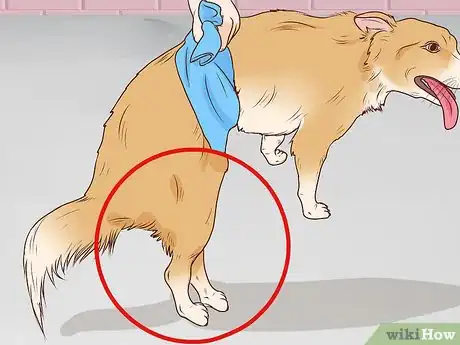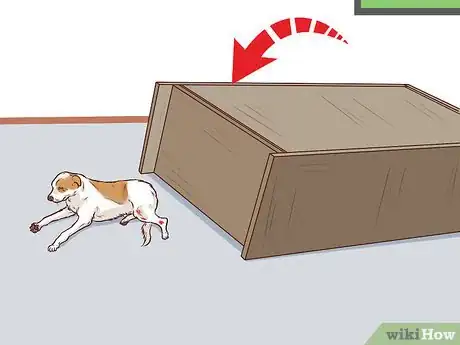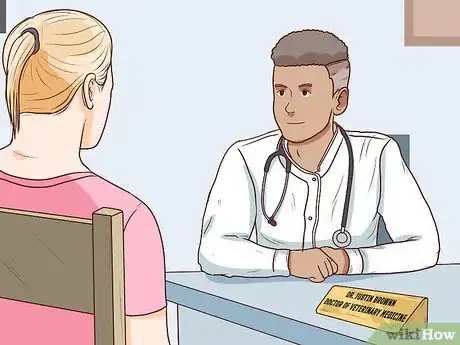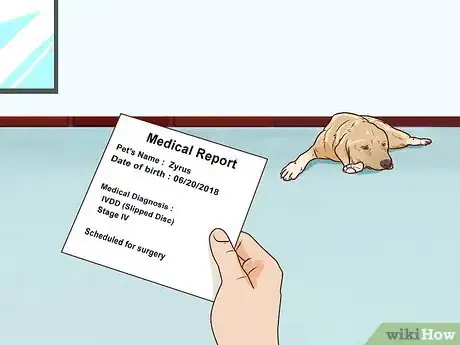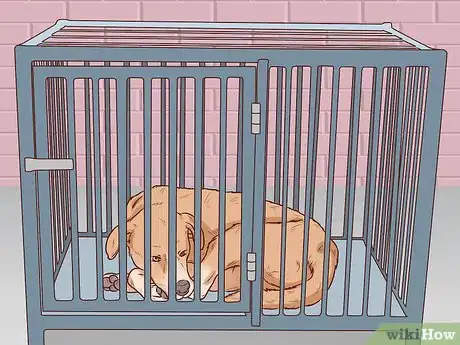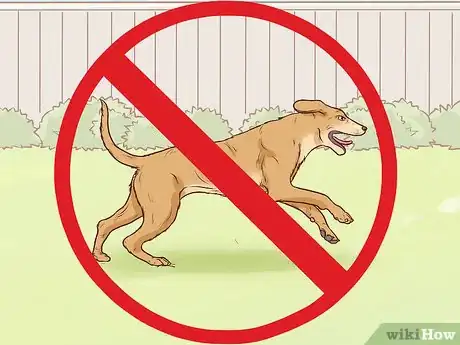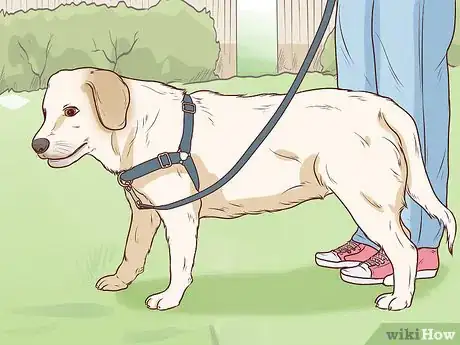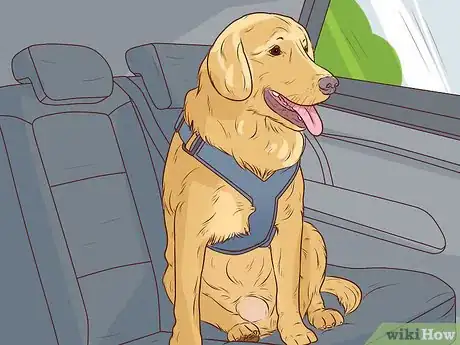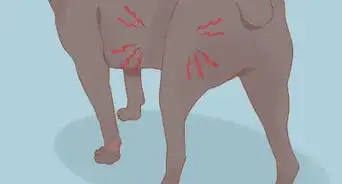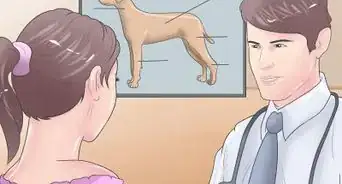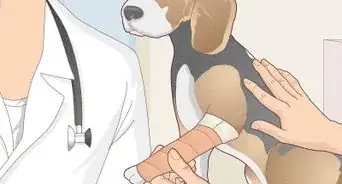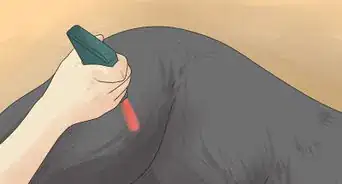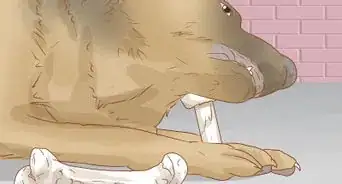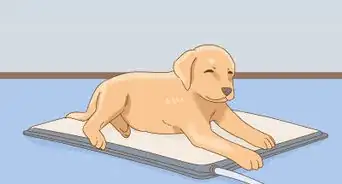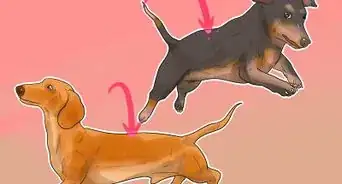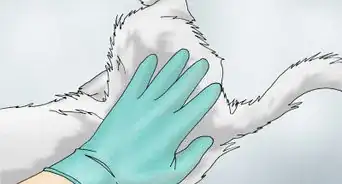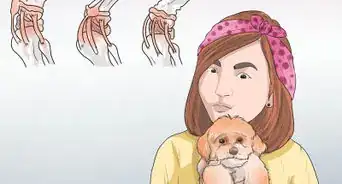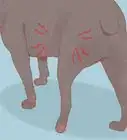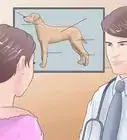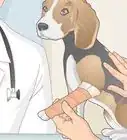This article was co-authored by Pippa Elliott, MRCVS. Dr. Elliott, BVMS, MRCVS is a veterinarian with over 30 years of experience in veterinary surgery and companion animal practice. She graduated from the University of Glasgow in 1987 with a degree in veterinary medicine and surgery. She has worked at the same animal clinic in her hometown for over 20 years.
This article has been viewed 60,617 times.
Dogs are susceptible to slipped discs in their backs, just like people. The intervertebral disc is a soft cushion that sits in the joints between the spinal vertebrae.[1] A slipped or herniated disc can afflict any dog due to a spinal injury, but some dog breeds are particularly susceptible to back problems like intervertebral disc disease (IVDD).[2] There is no way to prevent IVDD or slipped discs, but with the proper knowledge and planning, you can reduce your dog's risk of injury and nurse an injured dog back to health.
Steps
Diagnosing a Slipped Disc
-
1Recognize the symptoms. It can be difficult to diagnose a slipped disc or IVDD at home. That's because the precise location of the affected vertebrae and the degree of injury can affect how noticeable your dog's injury is.[3] However, some common symptoms to look for include:
- neck pain
- back pain
- difficulty moving
- a wobbly, uneven stride
- inability to place paws flat on the ground
- dragging one or more paws
- complete paralysis
-
2Assess any recent trauma. Some dog breeds are prone to developing skeletal problems. However, all dogs are capable of experiencing a slipped disc if they are seriously hurt.[4]
- If your dog has fallen from any height, been hit by a person or object, or been involved in a traffic accident (including being in the car during one), your dog may have sustained spinal injuries.
- If you suspect your dog has sustained a spinal injury due to physical trauma, contact your veterinarian immediately.
Advertisement -
3Identify breeds prone to skeletal problems. While skeletal problems can afflict any dog breed, these issues tend to strike dogs with disproportionately short limbs. However, some larger dog breeds are also afflicted.[5] Many dog breeds prone to back problems like intervertebral disc disease (IVDD) end up suffering from herniated or slipped discs.[6] Some breeds commonly afflicted by IVDD include:
- Dachshunds
- Pekingese
- Shih Tzus
- Beagles
- Some poodles
- Cocker spaniels
- Welsh corgis
- Basset hounds
- Labrador retrievers
- German shepherds
- Shar-peis
-
4Make an appointment with your vet. Whether your dog is of a breed prone to IVDD or has sustained a spinal injury, your vet will need to see your dog right away. A vet can help rule out other problems, diagnose the problem with your dog, and recommend a treatment plan.[7]
- Your vet will need to perform a full neurological exam, as X-rays alone are usually insufficient at identifying a slipped disc.
- Some tests your vet may run include an X-ray with dye contrast, a computed tomography (CT) scan, magnetic resonance imaging (MRI), or some combination of these tests.
- Your vet may also draw a small sample of cerebral spinal fluid to rule out a spinal infection.[8]
-
5Learn your dog's prognosis. When your vet determines that your dog has a slipped disc, they will also be able to assess how severe the injury is. If the slipped disc was caused by trauma, your vet will instruct you on how to heal it. If it was caused by degenerative disc disease, your dog may require a more comprehensive treatment plan.[9] How intensive your treatment plan is will depend on how advanced the degenerative disc disease is. There are five stages of disc disease, including:
- Stage I - mild pain which usually heals on its own within a few days
- Stage II - moderate to severe pain
- Stage III - partial paralysis resulting in staggered or uncoordinated walking patterns
- Stage IV - paralysis with feeling intact
- Stage V - paralysis and total loss of feeling
Treating a Slipped Disc
-
1Restrict your dog's movement. Regardless of how your dog's spinal injury developed, you will need to restrict its ability to move for a period of time. You may need to keep your dog confined for up to six weeks, depending on the severity of your dog's injury and your vet's recommendations.[10]
- Keep your dog temporarily confined to a small space, like a dog cage or an enclosed area.
- Do not let your dog run, jump, or twist at all.
-
2Administer medication. Anti-inflammatory drugs and/or pain relievers may be prescribed for dogs with moderate to severe pain, including partial paralysis. Some dogs who do not respond to medication or who have advanced degenerative disc disease may need surgery.[11]
- Common nonsteroidal anti-inflammatory drugs (NSAIDs) used for back pain include Rimadyl (carprofen), Etogesic (etodolac), and Deramaxx (deracoxib).[12] You will need a prescription for these medications.
-
3Consider surgery. Surgery is usually recommended when your dog has had more than one slipped disc, has persistent severe pain, or has had severe nervous system complications.[13] Surgery is most effective when performed with the first few days of the injury, which is why it's imperative that you have your dog seen by the vet at the first sign of injury.[14]
- Talk to your vet about whether surgery may be right for your dog. Only your vet can determine the best course of action to treat your dog's injury.
Preventing Slipped Discs
-
1Limit high-impact activities. Dogs love to run, jump, and play, but doing any of these activities too roughly can easily lead to spinal injuries. If your dog has suffered spinal injuries in the past, or if it's of a breed that is susceptible to spinal problems, you may need to monitor and restrict your dog's activity.[15]
- Consider installing a small pet staircase so your dog doesn't have to jump on or off of furniture. You can purchase a pet staircase at many pet stores or through an online retailer.
- Limit or restrict running, as this may aggravate an injury-prone spine.
- If your dog plays with other dogs and they tend to play roughly, consider limiting your dog's playtime with that dog.
-
2Use a harness instead of a collar. You should always use a leash to walk your dog. However, instead of clipping that leash to your dog's color, consider using a chest harness. These devices slip easily onto your dog's torso, and you can attach any standard leash to a harness.[16]
- When you pull on the leash, a harness will distribute that pressure across the dog's body. With a collar leash, your dog's neck and upper back receive most of the force.
- You can purchase dog harnesses at most pet stores or through an online retailer.
-
3Travel safely with dogs in your vehicle. Any time you drive somewhere, you should always buckle up your seatbelt. The same is true of your dog. If your dog is freely roaming the vehicle and you make a sudden stop or are involved in a collision, your dog can seriously injure its back and neck. By taking precautions any time your dog travels with you, you can significantly reduce the risk of injury.
- Make sure your dog is used to traveling in a vehicle before you attempt any long drives with your pet. A stressed dog may wiggle, jump, and try to move around the vehicle.
- Use a travel harness to keep your dog securely fastened in place during car trips. You can purchase a travel harness at many pet stores or through an online retailer.
- Consider a skybox or booster seat, which is used in conjunction with a harness to keep your dog fastened in a cushioned box.
- If you have a vehicle with a hatchback or "boot," you may want to consider using a car grid. This metal grate fits over the backseat's headrest, keeping your dog confined to the trunk area during car trips.
Warnings
- If you suspect your dog has sustained a spinal injury, don't wait. Get your dog to the vet as soon as possible, as your dog's prognosis may depend on how quickly the injury is treated.⧼thumbs_response⧽
References
- ↑ http://vetspecialists.co.uk/factsheets/Neurology_Facts/Slipped_Disc.html
- ↑ http://www.vetstreet.com/our-pet-experts/slipped-discs-in-dogs-signs-tips-to-prevent-it-and-breeds-most-at-risk
- ↑ http://www.vetstreet.com/our-pet-experts/slipped-discs-in-dogs-signs-tips-to-prevent-it-and-breeds-most-at-risk
- ↑ http://vetspecialists.co.uk/factsheets/Neurology_Facts/Slipped_Disc.html
- ↑ https://www.dvm360.com/view/treating-acute-disk-herniations-proceedings
- ↑ http://www.vetstreet.com/our-pet-experts/slipped-discs-in-dogs-signs-tips-to-prevent-it-and-breeds-most-at-risk
- ↑ http://vetspecialists.co.uk/factsheets/Neurology_Facts/Slipped_Disc.html
- ↑ http://www.peteducation.com/article.cfm?c=2+2105&aid=418
- ↑ http://www.vcahospitals.com/main/pet-health-information/article/animal-health/degenerative-disc-disease-in-dogs/738
- ↑ http://www.vcahospitals.com/main/pet-health-information/article/animal-health/degenerative-disc-disease-in-dogs/738
- ↑ http://www.vcahospitals.com/main/pet-health-information/article/animal-health/degenerative-disc-disease-in-dogs/738
- ↑ http://www.peteducation.com/article.cfm?c=2+2105&aid=418
- ↑ http://www.peteducation.com/article.cfm?c=2+2105&aid=418
- ↑ http://vetspecialists.co.uk/factsheets/Neurology_Facts/Slipped_Disc.html
- ↑ http://www.vetstreet.com/our-pet-experts/slipped-discs-in-dogs-signs-tips-to-prevent-it-and-breeds-most-at-risk
- ↑ http://www.vetstreet.com/our-pet-experts/slipped-discs-in-dogs-signs-tips-to-prevent-it-and-breeds-most-at-risk
About This Article
To know if your dog has a slipped disc, figure out if your dog recently experienced a trauma or injury, like falling from any height or being hit by a person or vehicle. Even if your dog hasn't suffered an injury, keep in mind that some breeds are naturally prone to skeletal problems. Next, look for common symptoms like neck pain, back pain, difficulty moving, dragging one or more paws, or paralysis. Then, make an appointment with your vet to confirm the diagnosis and discuss treatment plans. For tips on treating slipped discs at home, read on!
